At the outset, it looks like ordinary tteok. A bite into the Korean rice cake immediately brings a surprise, as where one might expect sweet red bean paste, you find a dizzyingly sweet filling of chocolate and almonds.
It is just one of many variations that Good Rice Cake Corp., a fusion rice cake shop, offers in its selection of fusion rice cakes along with traditional ones.
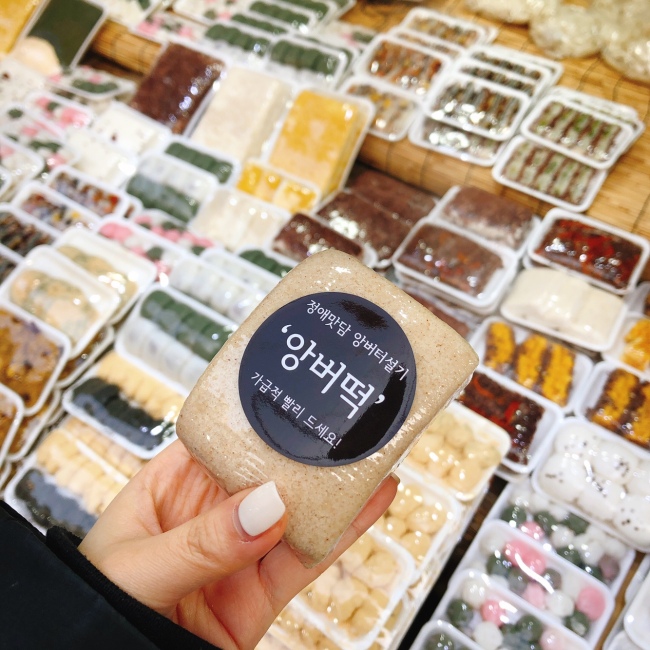 |
“Ang-beo tteok” and traditional tteok from Jung-ae-mat-dam (Kim Hye-soo / The Korea Herald) |
A market for rice cakes with innovative recipes has sprung up in South Korea in recent years, with many such products rising to fast popularity as a result of catchy marketing strategies.
Data shows that the popularity of rice cakes, known as tteok in Korea, has been picking up, with processed tteok sales increasing 14.8 percent to 112.2 billion won ($99.85 million) in 2017 from 97.7 billion won in 2015, according to data from the Korea Agro-Fisheries & Food Trade Corporation.
While much of the revenue increase was generated by rice cakes used for popular dishes like tteokbokki, demand is rising for fancier rice cakes as well. Major retailers, for their part, have put their own spin on traditional dessert tteok, a case in point being convenience store chain CU’s Real Mochi Roll, of which some 1.5 million were sold in three months.
But it is mom and pop stores that are really leading the fad, building their reputations via active social media networking and word of mouth among social influencers.
Dduckbo Halu, launched in 2003, is Korea’s first franchise rice cake company. The rice cake brand started out in a small corner of the Dong-a Department Store in 2002 but now operates some 49 branches throughout Korea. The company doesn’t just produce traditional rice cakes but also offers many fusion products with unique ingredients like fruit jams and cream.
Jung-ae-mat-dam, a traditional rice cake store that also sells standard tteok sets, suddenly became a hot topic on social media in December 2017 with its new “Ang-beo tteok.” The treat was inspired by the popularity of “ang butter,” a fusion-style sandwich made of red bean paste and a cube of butter served on a bun.
“As we were a small store selling ordinary rice cakes, we wanted something fresh to attract the younger generation,” the CEO of Jung-ae-mat-dam told The Korea Herald.
“Seeing ang butter selling like hotcakes, we thought why not try putting it in rice cake buns instead of bread? It turned out to be a megahit.”
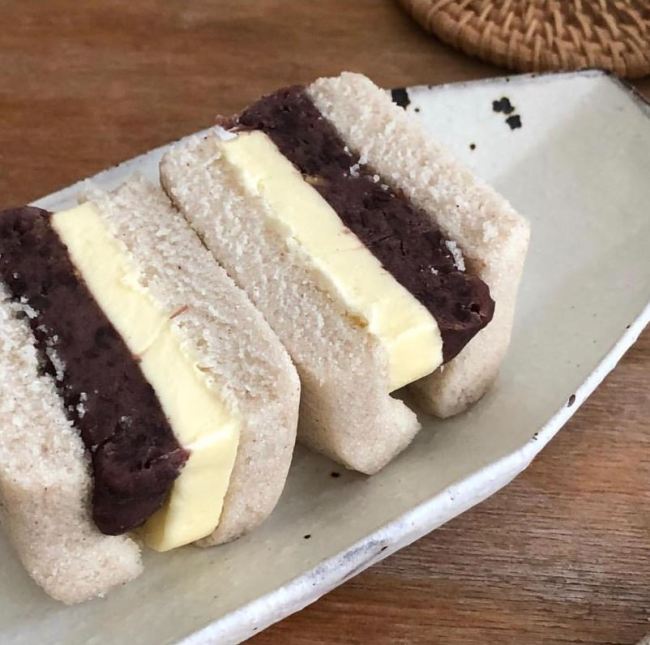 |
An “ang-beo tteok” is a sandwich made of red bean paste and cubes of butter between two rice cakes. (Jung-ae-mat-dam) |
The store is located in a traditional market in Isu, Seoul, and is frequented not only by older customers but also by many people in their 20s.
“We came here from Suwon (in Gyeonggi Province) to buy ang-beo tteok after seeing it on Instagram. People who have tried it strongly recommended it to us,” said a 25-year-old surnamed Baek.
The CEO says he sells about 300 ang-beo tteok every day.
Social media have emerged as an influential marketing tool for businesses looking to appeal to young people, as a single picture can reach mass numbers within seconds.
Lee Sang-ho, the CEO of the Good Rice Cake Corp., agrees.
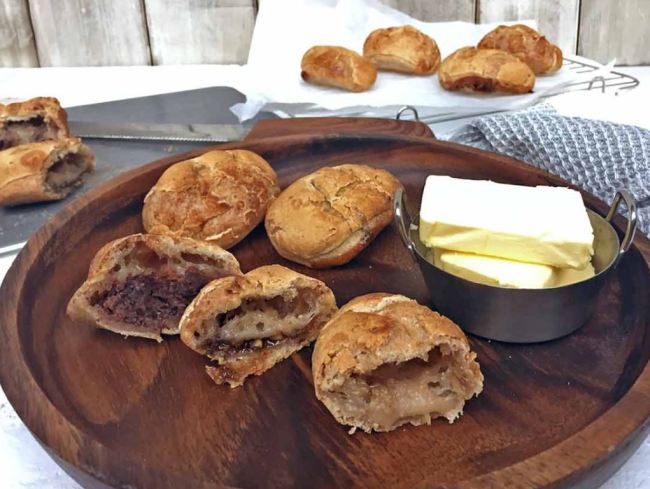 |
Good Rice Cake Corp.’s baguette-style tteok, a fusion product consisting of a rice cake stuffed inside a baguette (Good Rice Cake Corp.) |
“The barrier to starting a business in the rice cake industry was very high with the public recognizing it to be just conventional, the very perspective that we wanted to change.”
The fusion rice cake shop sells both ordinary traditional rice cakes and creative fusion products, with chocolate mochi and sweet rice cake baguettes at the forefront of the business. Social media brought many of the company’s most popular products into the public eye upon their release, with the key being the addition of ingredients that younger customers are used to.
“Now we send out more than 300 boxes a day for delivery, which is a huge improvement,” said company director Yoo Seung-chul, who estimates that people in their 20s and 30s comprise about 80 percent of the company’s customer base.
“Before, tteok was something people only bought at offline stores after seeing the product with their own eyes. Now, as online sales account for a bigger portion of the total, we have to pay special attention to the opinions of customers from far away since unexpected problems can happen when it gets delivered,” said Yoo.
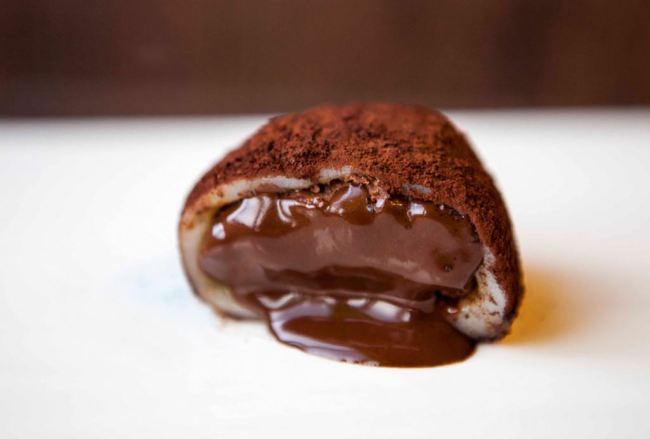 |
Chocolate mochi from Good Rice Cake Corp., filled with Belgian chocolate and powdered with chocolate (Good Rice Cake Corp.) |
Good Rice Cake Corp. is active on various social media platforms with more than 700 posts on Instagram, for example, and more than 20,000 Instagram followers.
Since Oct. 30, 2014, when revisions to the Food Sanitation Act took effect allowing delivery of tteok, the number of online tteok shops has increased.
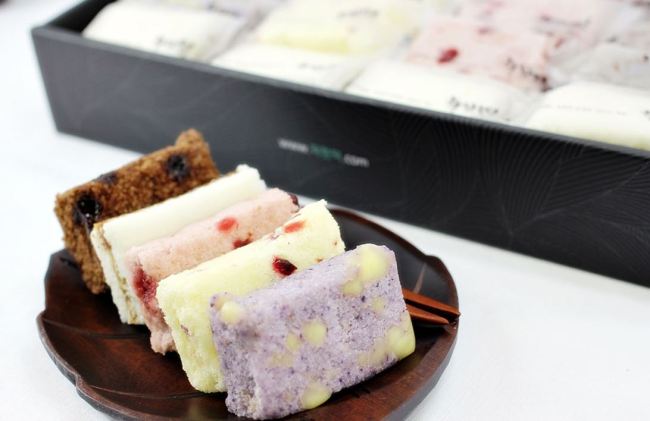 |
Fusion rice cakes (Good Rice Cake Corp.) |
“The way customers buy our products changed, so the market’s standard of service is also changing. It’s quite challenging to walk the path no one has walked yet, but we are more than happy to see our traditional snack getting popular once again,” said Lee.
By Kim Hye-soo (
clairek@heraldcorp.com)












![[Today’s K-pop] Blackpink’s Jennie, Lisa invited to Coachella as solo acts](http://res.heraldm.com/phpwas/restmb_idxmake.php?idx=644&simg=/content/image/2024/11/21/20241121050099_0.jpg)